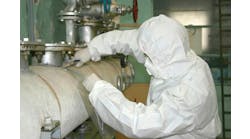IndustryWeek's elite panel of regular contributors.
Arguing that automation doesn’t provide value to manufacturers is like arguing that springtime is bad for farmers. No one, least of all the authors, would hold that there’s no room for well-implemented automation in operations. It can improve throughput, quality, and safety.
We don’t fully buy the “machines don’t take vacations” trope that so many managers like to glibly toss out: Did you ever see an employee surrounded by three engineers in the middle of the shift scratching their heads trying to figure out why the employee had simply stopped working on the part that had to be shipped that afternoon? On the other hand, we’ve both seen that automation can produce exceptional levels of accuracy and production volume with a high degree of repeatability. From robotic welding in body-in-white areas of an automotive assembly plant where the chassis of cars are transformed from raw stamped panels to a fully structured body ready for paint, to conveyor lines that coordinate with assembly steps, technology has evolved to the point where it can operate in a “lights out” environment and can be monitored remotely. It’s clear that automation can reduce waste, cycle times, and overall lead times while improving safety.
Cost and Complexity
That said, automation can come with hidden costs of its own. To get at those hidden costs, let’s take a step back to talk about complexity. The term “complexity” captures the number of variables that are embedded in an operation. It also captures the degree to which those variables are important to the operation. Finally, it captures the volatility of the variables. An operation is very complex when it comprises many variables, all of which are significant, and all of which are volatile. Complexity increases costs, opportunities for waste and is difficult to manage. As such, a goal of any lean initiative is to eliminate complexity where we can and reduce it when we can’t eliminate it.
Imagine a manufacturer that buys one component from one supplier, then transforms that component via one manufacturing operation into one product that is sold to one customer. That’s as simple an operation as we can describe; it has few variables and is low complexity. Yet, even in our “low complexity” scenario, it’s not difficult to imagine all the things that can disrupt the flow of material from supplier to customer. As we increase the complexity of our imaginary operation (more components from more suppliers turned into more products through more manufacturing steps that are sent to more customers), costs rise and the opportunities for waste increase. To be sure, at least some of that increased complexity adds value in that more products sent to more customers is to everyone’s advantage. It remains true, though, that managing complexity effectively is essential if quality, customer service, and margins are to be kept high.
That’s where lean comes in; lean helps us manage complexity. From shadow boards to standard work to kanban, lean tools are effective in making the flow of materials and information easier to accomplish and easier to monitor. The primary goal of workplace organization, for example, isn’t simply “good housekeeping.” An organized workplace is less complex than is a workplace in disarray. When integrated with visual controls, it’s possible to tell, at a glance, whether processes are in control or not. We can do that because the complexity within the process has been reduced or eliminated. Reduced complexity improves throughput and quality.
Automation typically increases complexity within manufacturing operations. Investments in a wide array of spare parts for automated systems are often necessary so that failed parts can be swapped out quickly. These spare parts can be expensive and lead times for getting replacements might be long. Like all inventory, material sitting on the shelf in the form of idle but necessary spares has its own costs (carrying, space, utility, damage, and obsolescence).
Making Things Worse?
Worse yet, the automation itself can often increase complexity if not designed and installed well. Ron worked for a bottling plant that had installed an automated operation that was designed to run with just four employees. The actual uptime of the production line was only 40%. The equipment had been designed for filling glass containers rather than much lighter blow-molded bottles, which were variable in shape and weight. The lighter containers often fell over when empty, jamming conveyor lines. Further, the lines were located well above floor level. Filling operations were often stopped as the operators were forced to climb to the conveyor to unjam the line. Operators worked hard to keep these finicky lines running at even 40% availability.
In another instance, Ron worked for a contact lens maker that injection molded polycarbonate lenses using automation to make hundreds of thousands of lenses per shift. The complex automation required engineers, maintenance and other personnel literally standing alongside the equipment throughout the shift to assure uninterrupted operation.
The components of this equipment would wear down, sometimes within just hours of replacement. During these breakdowns, operators using manual cutters kept the line running. The disruption to material flow created significant shortages for downstream operations.
We don’t provide these illustrations to argue against automation. Rather, our argument is that automation implemented without careful planning can increase complexity. Such automation might improve throughput (though not always, as per our illustrations) but it can also add hard-to-manage variability to the process.
Simple, Improved, Involved
How can a manufacturer benefit from automation without introducing needless and costly complexity? First, avoid automation that simply increases output at one step of a manufacturing process. Rather, implement automation that improves flow of material throughout the process. Automation of bottlenecks can obviously achieve both improved output at a specific process step and improve overall flow. Automation of steps that aren’t bottlenecks runs the risk of increasing complexity without improving the process.
A past client of Rick’s extruded 8” PVC pipe in 20-foot lengths. The heavy pieces were moved by laborers from the end of the extruder to carts. Ergonomic injuries, damaged product, and delays were common until the company installed robots to pick the pipe from the end of the line and place it in the carts. The laborers had more time to attend to the quality inspections and other duties for which they were responsible. The client had inserted automation that improved the flow of the overall process while enhancing worker health and safety.
Second, invest in the simplest technology that provides the needed benefits. Another of Rick’s clients eventually sued the vendor of a robot cell that, after more than a year of experimentation, never worked. Essentially, the vendor over-promised as to what the complex robotic cell was able to do. My client got excited about all the process steps that were going to be eliminated by the one installation. The promised increase in throughput (which had never been a particular problem) was never realized because the sophisticated automation exceeded the organization’s ability to install and maintain it.
“Simplest technology” means easy to install, easy to bring to full capability, easy to maintain and easy to troubleshoot. Often, the simplest technology can be designed and installed in-house. The same client that benefitted from the PVC pipe-handling robots also owned an injection molding plant in Ohio. The engineers at that plant built and successfully implemented small “robots” that removed runners from molds or applied glue to parts. In both instances, manual steps that had been associated with slow flow of material and high reject rates were eliminated. Another of Rick’s clients has successfully implemented robots that free operators from the task of removing flash from large plastic parts. That automation has actually made it easier to retain good employees.
Finally (but perhaps most importantly), never implement new technology without getting the people who are embedded in the process involved with the design, acquisition, and installation of the new automation. The instances of automation reported above worked well because they addressed problems that the operators themselves brought to the engineers’ attention. Those same operators were able to provide input to design and application of the automation.
Lean, then, has no quarrel with automation so long as it improves flow throughout the manufacturing process and addresses frustrations experienced by operators.
Ron Jacques is a 35-year veteran within the lean, manufacturing and consulting arenas. He is a Certified Lean Practitioner who has delivered hundreds of kaizen and transformational solutions to clients and companies within the Pharma, Medical Device, Automotive, Food/Beverage, Electronics, Military Defense, Personal Care, Consumer Durables and Capital Equipment industries.
Rick Bohan, principal, Chagrin River Consulting LLC, has more than 25 years of experience in designing and implementing performance improvement initiatives in a variety of industrial and service sectors. He is also co-author of People Make the Difference: Prescriptions and Profiles for High Performance.





